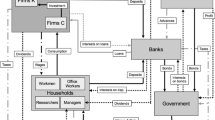Abstract
This paper studies the dynamic general-equilibrium interactions between inequality, crime and economic growth by embedding the rational choice-theoretical approach to criminal behavior in a heterogeneous-agents endogenous-growth OLG model. Based on their respective opportunity costs, individuals choose to specialize in either legal or criminal activities. While legal households contribute to aggregate goods supply over time by either working or building human capital, criminals make a living by expropriating legal citizens of part of the latter's income. An increase in inequality lowers the economy's growth rate and possesses negative welfare effects for all agents with endowments equal to or above average and for agents with endowment below average that are born sufficiently far in the future.
Similar content being viewed by others
References
Aghion, P. and P. Bolton. (1997). “A Theory of Trickle-Down Growth and Development.” Review of Economic Studies 64, 151-172.
Aghion, P., E. Caroli and C. García-Peñalosa. (1999). “Inequality and Economic Growth: The Perspective of the New Growth Theories.” Journal of Economic Literature 37, 1615-1660.
Aghion, P. and P. Howitt. (1998). Endogenous Growth Theory. Cambridge, MA: MIT Press.
Alesina, A. and D. Rodrik. (1994). “Distributive Policies and Economic Growth.” Quarterly Journal of Economics109, 465-490.
Banerjee, A. and A. Newman. (1993). “Occupational Choice and the Process of Development.” Journal of Political Economy 101, 274-298.
Becker, G. S. (1968). “Crime and Punishment: An Economic Approach.” Journal of Political Economy 76, 169-217.
Bénabou, R. (1996). “Inequality and Growth.” NBER Macroeconomics Annual 11, 11-74.
Benhabib, J. and A. Rustichini. (1996). “Social Conflict and Growth.” Journal of Economic Growth 1, 125-142.
Benoit, J. P. and M. J. Osborne. (1995). “Crime, Punishment, and Social Expenditure.” Journal of Institutional and Theoretical Economics 151, 326-347.
Bertola, G. (1993). “Factor Shares and Savings in Endogenous Growth.” American Economic Review 83, 1184-1198.
De Gregorio, J. and S.-J. Kim. (2000). “Credit Markets with Differences in Abilities: Education, Distribution, and Growth.” International Economic Review 41, 579-607.
Easterly, W. and S. Rebelo. (1993). “Fiscal Policy and Economic Growth.” Journal of Monetary Economics 32, 417-58.
Ehrlich, I. (1973). “Participation in Illegitimate Activities.” Journal of Political Economy 81, 521-565.
Ehrlich, I. (1996). “Crime, Punishment, and the Market for Offenses.” Journal of Economic Literature 10, 43-67.
Freeman, R. B. (1996). “Why Do so Many Young American Men Commit Crimes and What Might We Do About It?.” Journal of Economic Literature 10, 25-42.
Galor, O. and J. Zeira. (1993). “Income Distribution and Macroeconomics.” Review of Economic Studies 60, 35-52.
Grossman, H. I. (1991). “A General Equilibrium Model of Insurrections.” American Economic Review 81, 912-921.
Grossman, H. I. (1995). “Robin Hood and the Redistribution of Property Income.” European Journal of Political Economy 11, 399-410.
Grossman, H. I. and M. Kim. (1996). “Inequality, Predation and Welfare.” NBER Working Paper No. 5704.
Imrohoroglu, A., A. Merlo and P. Rupert. (2000). “On the Political Economy of Income Redistribution and Crime.” International Economic Review 41, 1-25.
Laband, D. N. and J. P. Sophocleus. (1992). “An Estimate of Resource Expenditures on Transfer Activity in the United States.” Quarterly Journal of Economics 107, 959-984.
Mathur, V. (1978). “Economics of Crime: An Investigation of the Deterrent Hypothesis for Urban Areas.” Review of Economics and Statistics 6, 459-466.
Okun, A. M. (1975). Equality and Efficiency. Washington: Brookings Institution.
Perotti, R. (1992). “Income Distribution, Politics, and Growth.” American Economic Review 82, 311-316.
Perotti, R. (1993). “Political Equilibrium, Income Distribution, and Growth.” Review of Economic Studies 60, 755-776.
Perotti, R. (1996). “Growth, Income Distribution, and Democracy: What the Data Say.” Journal of Economic Growth 1, 149-187.
Persson, T. and G. Tabellini. (1994). “Is Inequality Harmful for Growth? Theory and Evidence.” American Economic Review 48, 600-621.
Posner, R. A. (1975). “The Social Costs of Monopoly and Regulation.” Journal of Political Economy 83, 807-827.
Pyle, D. J. (1983). The Economics of Crime and Law Enforcement. New York: St. Martin Press.
Saint-Paul, G. and T. Verdier. (1993). “Education, Democracy, and Growth.” Journal of Development Economics42, 399-407.
Sala-i-Martin, X. (1997). “Transfers, Social Safety Nets, and Economic Growth.” IMF Staff Papers 44, 81-102.
Smith, E. and R. Wright. (1992). “Why Is Automobile Insurance in Philadelphia so Damn Expensive?.” American Economic Review 82, 756-772.
Spiegel, H. W. (1991). The Growth of Economic Thought, 3rd ed. Durham and London: Duke University Press.
Stigler, G. J. (1970). “The Optimum Enforcement of Laws.” Journal of Political Economy 78, 526-536.
Tollison, R. D. (1997). “Rent Seeking.” In D. C. Mueller (ed.), Perspectives on Public Choice. Cambridge: Cambridge University Press.
Author information
Authors and Affiliations
Rights and permissions
About this article
Cite this article
Josten, S.D. Inequality, Crime and Economic Growth. A Classical Argument for Distributional Equality. International Tax and Public Finance 10, 435–452 (2003). https://doi.org/10.1023/A:1024683431555
Issue Date:
DOI: https://doi.org/10.1023/A:1024683431555




